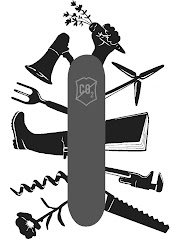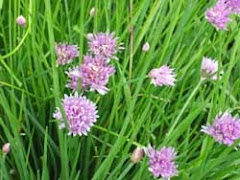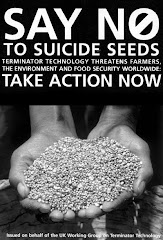Truly disgusting, utterly sick, very scary - loved it! Banks describes it as "a bit like The Wasp Factory except without the happy ending and redeeming air of cheerfulness". Had to put it down a few times to breathe and uncurl my toes...
Don't go looking on Amazon - support independent booksellers!
Saturday, 26 May 2007
Thursday, 24 May 2007
Composting Tea Bags
I’m sure I’ve always composted tea bags, long before I ever composted anything else. In one house I used to just chuck them out in the garden straight from the kitchen window, since they don’t smell as they break down and apparently some plants like a bit of caffeine. I drink a lot of tea and I’ve never thought twice about composting the bags – it seems obvious, and I’ve been doing it so long I can’t remember where I first got the idea.
I’ve just used the last of this year’s compost on my seedlings, and emptying the bin this year I’ve had unpleasant surprises*. Pulling out odd pieces of plastic and woody bits I kept finding fluffy white fibrous stuff stuck in there, like duvet filling in small patches stuck fast to and tangled up with everything else. I pulled one out after another but they kept appearing, so I looked at different parts of the pile and found them spread out through the whole heap. Even the blackest, crumbliest parts had these stupid blobs in them, either solid little black lumps in stringy white** mesh bags, or stringy white mesh bags full of worms.
I’ve had several thousand cups of tea since I last emptied the compost bin and I’ve put every single used tea bag into the damned thing, and now every single one is sitting there waiting for me to take it out before I can use a year’s worth of compost. Since when are teabags not made of PAPER???
It’s dead fashionable to compost these days – even the Guardian is explaining how to do it – so there are millions of sites, books, factsheets and community projects out there to tell anyone who’ll listen how to put things in a pile and leave it alone for a while. After trawling through a few of them and rolling my eyes quite a lot (Q: My compost bin is full of pests! After only two weeks it’s all full of horrible woodlice and millipedes – what did I do wrong?) I finally submitted a question to WRAP.
After a long time, I got this back:
“The answer is that not enough companies specify their tea bag materials, which can be plastic or paper based. So, two batches of tea bags from the same tea company may have used different materials. You will need to contact the tea bag company I am afraid.”
Right. They get together a big organisation for “supporting compost producers and growing markets for compost products”, but encouraging tea bag producers to create something I can put IN my compost is left to me the individual. Thanks a lot.
I did give up at this point, but then another hour pulling all the little white mesh bags full of worms out of my compost spurred me on again to find a contact e-mail for “the tea bag company” and ask them. I got this reply:
“Thank you for your email and your comments. I would like to confirm to you that our Teadirect teabags are made from polyester which is fairly typical for all teabags as far as I am aware. Yes you are right, unfortunately they are non-recyclable and non-biodegradable.. The best method for disposal is to burn for heat recovery. I would be very grateful of any feedback you have with regards to any alternative teabags that you have come across which I would gladly pass onto our marketing department for their consideration as we are continually carry out research to find more environmentally friendly products. I look forward to hearing from you.”
How many tea bags would I have to burn to boil a kettle then?
Strangely enough, when they’re dry they do burn remarkably well, which leaves me with no way of telling which tea bags are still made from paper, since the usual test for man-made fibres is that they melt slightly (or a lot) when you burn them.
So, the question now is this; should I a) try to make WRAP or maybe the Guardian lifestyle and fashion department compile a list of compostable tea bags, b) ask all the tea bag companies myself which would be more hassle but quicker, or c) get a life, stop composting my tea bags and experiment with using loose-leaf tea, which would probably be more hassle in the end over the course of a lifetime.
Answers on a postcard if you wish, so long as it’s a bloody PAPER postcard.
* The first few were surprising anyway. The next 6000 were just unpleasant.
** Fellow gardeners will appreciate the meaning of “white” in the context of a compost bin compared to the meaning of “white” in, say, a Persil ad.
COMMENTS
I’ve just used the last of this year’s compost on my seedlings, and emptying the bin this year I’ve had unpleasant surprises*. Pulling out odd pieces of plastic and woody bits I kept finding fluffy white fibrous stuff stuck in there, like duvet filling in small patches stuck fast to and tangled up with everything else. I pulled one out after another but they kept appearing, so I looked at different parts of the pile and found them spread out through the whole heap. Even the blackest, crumbliest parts had these stupid blobs in them, either solid little black lumps in stringy white** mesh bags, or stringy white mesh bags full of worms.
I’ve had several thousand cups of tea since I last emptied the compost bin and I’ve put every single used tea bag into the damned thing, and now every single one is sitting there waiting for me to take it out before I can use a year’s worth of compost. Since when are teabags not made of PAPER???
It’s dead fashionable to compost these days – even the Guardian is explaining how to do it – so there are millions of sites, books, factsheets and community projects out there to tell anyone who’ll listen how to put things in a pile and leave it alone for a while. After trawling through a few of them and rolling my eyes quite a lot (Q: My compost bin is full of pests! After only two weeks it’s all full of horrible woodlice and millipedes – what did I do wrong?) I finally submitted a question to WRAP.
After a long time, I got this back:
“The answer is that not enough companies specify their tea bag materials, which can be plastic or paper based. So, two batches of tea bags from the same tea company may have used different materials. You will need to contact the tea bag company I am afraid.”
Right. They get together a big organisation for “supporting compost producers and growing markets for compost products”, but encouraging tea bag producers to create something I can put IN my compost is left to me the individual. Thanks a lot.
I did give up at this point, but then another hour pulling all the little white mesh bags full of worms out of my compost spurred me on again to find a contact e-mail for “the tea bag company” and ask them. I got this reply:
“Thank you for your email and your comments. I would like to confirm to you that our Teadirect teabags are made from polyester which is fairly typical for all teabags as far as I am aware. Yes you are right, unfortunately they are non-recyclable and non-biodegradable.. The best method for disposal is to burn for heat recovery. I would be very grateful of any feedback you have with regards to any alternative teabags that you have come across which I would gladly pass onto our marketing department for their consideration as we are continually carry out research to find more environmentally friendly products. I look forward to hearing from you.”
How many tea bags would I have to burn to boil a kettle then?
Strangely enough, when they’re dry they do burn remarkably well, which leaves me with no way of telling which tea bags are still made from paper, since the usual test for man-made fibres is that they melt slightly (or a lot) when you burn them.
So, the question now is this; should I a) try to make WRAP or maybe the Guardian lifestyle and fashion department compile a list of compostable tea bags, b) ask all the tea bag companies myself which would be more hassle but quicker, or c) get a life, stop composting my tea bags and experiment with using loose-leaf tea, which would probably be more hassle in the end over the course of a lifetime.
Answers on a postcard if you wish, so long as it’s a bloody PAPER postcard.
* The first few were surprising anyway. The next 6000 were just unpleasant.
** Fellow gardeners will appreciate the meaning of “white” in the context of a compost bin compared to the meaning of “white” in, say, a Persil ad.
COMMENTS
Sunday, 20 May 2007
My Neighbour's Cat
Aaah, isn’t she sweet… 


She couldn’t possibly have anything to do with this pot having been knocked over.

I expect the french beans suddenly attacked her, which would explain the big crash I heard and would have been why she was running away from it so fast. Poor thing must have been frightened.
Aaaah…

Subscribe to:
Comments (Atom)
















